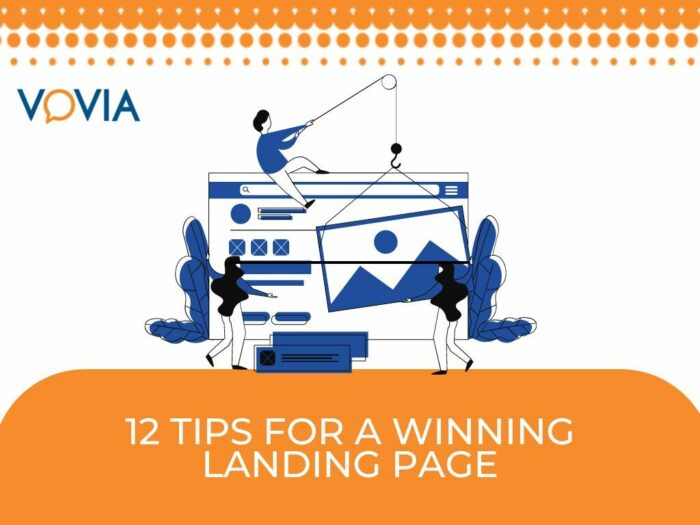12 Tips for a Winning Landing Page That Converts
Landing pages are one of the most common and effective marketing tools in the digital world.
The goals of a landing page are to sell a certain product or service, whether it’s on the landing page itself, by leaving contact information in order to get a call back from a representative, collecting potential customer details or building your mailing list.

You might be wondering why you need a landing page when you already have a website with details about all your products or services. It’s important to understand the difference: a website is like the central base of the business, where customers would find information about products or services, pricing, photos, blogs, etc. A landing page is an extension of the website but its purpose is more focused. A common purpose of a landing page is to interest the visitor in a specific product or service so they leave their personal details in order to receive additional details or make an immediate purchase.
So whether you have an active landing page or whether you are in the middle of building it, we have gathered 12 tips for you to use in order to produce a winning landing page with an improved conversion rate.
#1 Determine the purpose of the page
The construction of the landing page begins long before you start writing it. One of the most important things to know before you start is to deeply understand what you wish to promote and determine the purpose of the page. Fully consider the product/service’s advantages, disadvantages, the competition, what materials you have at your disposal, who is your target audience, what is your specific value proposition, and how you want to position this to your audience. If you are the business owner you should carefully examine these parameters, and if you’re a marketer you must thoroughly research it with the client.
#2 Know your audience
In the first tip we talked about the importance of knowing the details. A commonly missed detail is identifying who the target audience is for a landing page. A lot of businesses see themselves as their own ideal client and focus their landing page on what they want to say, rather than what the customer wants to hear. They really want to talk about the specifics of the product or service, while the visitors want to read what they will benefit from it. Therefore, before you start planning your landing page, you must create a desired customer profile. Only after you have an idea who you are speaking to will you be able to correctly catch their attention. Then, focus on the desired outcomes that the visitor wishes to achieve.
#3 Stay focused
One of the significant differences between a landing page and a website is the focus and goal of the content. While a website contains explanations and details about the business’s overall product portfolio, a landing page usually markets one product/service. That is why it is very important to focus the landing page on the benefits of that product or service. Avoid expanding too much on other services or products of the business, and try to limit external links, as they will drive attention away from the landing page’s main objective.
#4 Converting video
A known fact in marketing is that a good video, positioned correctly, that presents the marketed product properly, will improve conversion rates significantly. Videos are a great and appealing way to present the product or service. In most cases we’d recommend placing the video in the ‘above the fold’ section – the part of the page that visitors see without scrolling, and preferably place a registration form right beside it. The role of the video is to explain the marketed product or service clearly, to catch the visitor’s attention, and once they are attentive and focused, to motivate him to leave their details.
#5 Attention grabbing headline
When a visitor arrives on your landing page you have a couple of seconds to grab their attention. If the visitor doesn’t get interested in these few seconds they won’t scroll down, won’t see additional information and they will leave the page and move on. This is why a strong and appealing ‘above the fold’ section is important for any website or landing page. A good way to grab the visitors’ attention is to place 1-3 thought provoking questions, which are relevant to the problem that they wish to solve with your product or service. The second you grab a visitor’s attention, they naturally will want to read what you have to offer and will scroll down. If you are promoting a health-focused summit or conference for example, don’t start with the line-up or with the ticket pricing, start with the benefits that the visitor will gain from attending the summit, but put them in the form of a question. Instead of writing “the way for a healthier life” write “have you always wanted to know how to live healthier?”.
#6 Go with the flow
When structuring a landing page it is important to think about the process that we take the visitors through. We should minimize jumping from one subject to another. A good landing page structure will start with generating interest, move on to details about the product or service, and finish with the details and a form submission.
#7 Grab their attention, go BOLD
Even though you put a lot of effort into writing the landing page, most of the visitors won’t read everything. That’s why it is important to highlight key sentences and use interesting visuals. The “Sign Up Now”/”Submit” button should use a noticeable color which is different from the background and overall colour scheme of the page. Also, use interesting micro-copy like “Yes, sign me up to…” rather than the usual “Send”.
#8 Fear of missing out
When a visitor feels that they stumbled upon a golden opportunity that they might miss, the more they will be inclined to leave their details or purchase the product. This notion is called “fear of missing out” and you’re probably familiar with it. This can be achieved in numerous ways, but one of the most popular (and easy ways) is creating a limited-time offer with a clear end date. We can use the health summit example again: ticket pricing that goes up as the summit date approaches will push potential attendees to decide now, before the price goes up.
#9 Stick to the minimum
Most people are hesitant to share their personal information and they want to closely protect their privacy. Therefore, when you ask landing page visitors to leave details, be sure that you ask the bare minimum that you need. Each additional information field in the form is decreasing the conversion percentage of the page.
#10 Visuals visuals visuals
After you write your landing page’s content, make sure you have a coherent flow, and you are content with all the details, you need to give thorough thought about the landing page’s visuals. Ideally work with an experienced web designer but with some creativity and the right platform you can do it alone too. You will need to find the right background, one that will give some life to the page while not obscuring it or making it hard to read. Put some images and/or other relevant elements that will send the right message to the visitors.
#11 Mobile first!
Even though we feel that there’s no need to explain it, here it is: Today most of the internet traffic is through mobile phones, so when you’re designing your landing page you MUST think about the mobile user experience. You must make sure that the page is user friendly, that the elements don’t break on mobile browsers, and most importantly that the forms are fillable.
#12 Pop-ups are not a bad word
Pop-ups have a bad reputation; not because they are bad but because website owners often use them badly. Pop-ups are actually a great way to improve landing page conversion rates when they are used correctly. A pop-up that triggers on exit intent for example, with an appealing additional discount for registration might convince the visitor to leave their email address even if they’re not sure about your product, and you’ll have another way to contact him with a value proposition.
We hope these 12 tips give you something to consider the next time you’re building a campaign landing page. To learn more about how landing pages can help improve your marketing campaigns, reach out today.
